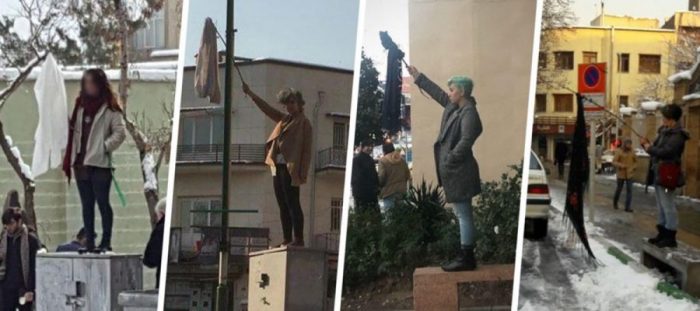The wave of people’s protests that swept across Iran beginning the end of 2017 and through the start of 2018 have been marked by demands for essentials such as job creation, food and water, as well as increased freedoms for a long-suffering and oppressed people.
Within the fabric of all those protests was the noteworthy and remarkable scene played out in cities and villages throughout Iran as women uncovered their heads by removing the proscribed hijab headscarves in silent protests.
Those iconic protesters were met with typical violence and brutality by the Iranian regime and human rights organization Amnesty International blasted the regime for its cruel treatment of women protestors to stifle dissent.
Amnesty International took note of a warning coming from Iranian regime police in a statement put out by the Mehr news agency warning that women could be jailed for up to a decade for joining any and all protests against veiling.
Amnesty International called it “an alarming escalation of the authorities’ violent crackdown on women’s rights.”
The group noted that more than 35 women have so far been violently attacked and arrested in Tehran alone since December 2017 for participating in peaceful protests. On the day that the regime issued its warning, one of the protestors, Narges Hosseini, was put on trial before an Ershad (Moral Guidance) court in Tehran on charges that included this new charge.
“This is a deeply retrograde move by the Iranian authorities in their ongoing persecution of women who dare to speak out against compulsory veiling. It places many women at serious and immediate risk of unjust imprisonment while sending a chilling message to others to keep quiet while their rights are being violated,” said Magdalena Mughrabi, Deputy Director for the Middle East and North Africa at Amnesty International.
The history of violence against women runs deep and long in the Islamic state where the mullahs issue hardline edicts designed to suppress women in areas such as domestic affairs, the job market, education and popular culture.
Restrictions placed on Iranian women have included bans on riding bicycles, the inability to gain divorces from abuses husbands, being forced into child marriages with much older male relatives and having scores of careers barred for women.
But the women thrown into Iranian prisons have endured some of the worst treatment.
At least one other woman, Shaparak Shajarizadeh, has been informed that she faces the charge of “inciting corruption and prostitution.” She is currently held in solitary confinement in Shahr-e Rey prison in Varamin, near Tehran. Her lawyer has said that she was subjected to torture or other ill-treatment, including beatings, in Vozara detention centre in Tehran following her arrest and was also injected with an unidentified substance several times by force and against her will.
The statement issued by regime police coincides with a recent upturn in police brutality against women’s solo protests – which see women take off their headscarves in busy public places and silently wave them on the end of a stick while standing on top of raised structures, according to Amnesty International.
Last Thursday, February 22, a video went viral on Persian social media showing a police officer recklessly pushing Maryam Shariatmadari off a concrete structure on which she was standing without a headscarf. Her friends have reported that the fall resulted in injuries requiring surgery. She is also held in Shahr-e Rey prison, without access to adequate medical care.
In recent weeks, the Iranian authorities, including the Chief Prosecutor of Iran and the Head of the Revolutionary Court in Tehran, have insulted women protestors by calling them “morons,” “infantile,” “deceived,” “perverted” and “wicked” and accused them of association with “foreign enemies.”
Iran’s judiciary spokesman Gholam-Hossein Mohseni-Eje’i has said that the women protesting against compulsory veiling are “acting under the influence of “synthetic drugs” or receiving instruction from “organized criminal groups.”
“The Iranian authorities must hold law enforcement officials to account for human rights violations, including torture and other ill-treatment and refrain from making any statements that incite further violence and abuse,” Mughrabi said.
While Amnesty International has focused on this latest round of abuses directed towards Iranian women, the latest episodes come as no surprise to seasoned Iranian dissident groups who have long championed the suffering of Iranian women by the regime, such as Mrs. Maryam Rajavi, the head of the National Council of Resistance of Iran, the largest Iranian dissident group.
By comparison, key Iran lobby members such as the National Iranian American Council, which is supposed to be an advocate for the human rights of Iranian-Americans, has stayed deafeningly silent on these latest abuses, as well as on the abuses suffered by dual-national women taken prisoner and held such as British social worker Nazanin Zaghari-Ratcliffe.
The pattern of abuse and intimidation, especially within regime-controlled media, encourages violence against women on the streets and makes liberal use of the morality police and paramilitaries to assault and beat these women.
Amnesty International noted that the regime’s policies stretch far back and have been a hallmark of the theocratic rule of the mullahs in Tehran in meeting any dissent with violence.
While these brave women continue their often lonely quests for equality and rights, it should be noted that the Iran lobby and NIAC are not supporters of theirs, nor defenders of those basic human rights.
Laura Carnahan
